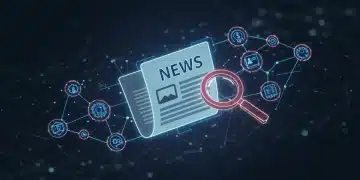Decentralized News Aggregators: Your Guide to Reliable US Sources

Decentralized news aggregators aim to provide unfiltered information, but identifying reliable sources in the US requires careful evaluation of platforms, source verification, and bias awareness to ensure informed consumption.
In an era of information overload, finding trustworthy news sources can feel like an impossible task. Decentralized news aggregators offer a potential solution by providing access to a wider range of perspectives, but navigating this landscape requires careful consideration and a critical eye, especially when focusing on reliable sources within the US.
Understanding Decentralized News Aggregators
Decentralized news aggregators represent a significant shift in how news is curated and consumed. Unlike traditional media outlets that rely on centralized editorial control, these platforms aim to distribute power and promote a more democratic flow of information. But what exactly are they, and how do they work?
What Defines a Decentralized News Aggregator?
A decentralized news aggregator is a platform that collects and presents news from a variety of sources without a central authority dictating which stories are prioritized or how they are framed. This approach can lead to a more diverse range of perspectives, as it’s less susceptible to the biases of a single editorial team.
How Do They Operate?
These aggregators often utilize blockchain technology or peer-to-peer networks to ensure that information is distributed across multiple nodes, making it more resistant to censorship or manipulation. They may also rely on algorithms or community moderation to rank and filter news stories.

Key features of decentralized news aggregators include:
- Censorship resistance: The distributed nature of these platforms makes it difficult for any single entity to control or suppress information.
- Transparency: Many decentralized aggregators operate on open-source code, allowing users to see how the platform works and how news is curated.
- Community governance: Some platforms involve the community in decision-making processes, such as voting on which sources to include or how to rank stories.
In conclusion, decentralized news aggregators offer a unique approach to news consumption, but they also come with their own set of challenges. Understanding how these platforms operate is crucial for finding reliable sources in the US.
The Promise and Perils of Decentralized News
Decentralized news platforms offer an appealing alternative to traditional media, promising greater transparency and independence. However, this comes with a unique set of challenges. Understanding both the potential benefits and drawbacks is crucial for informed news consumption.
The Allure of Unfiltered Information
The primary appeal of decentralized news lies in its potential to provide unfiltered information, free from the influence of corporations, governments, or partisan interests. This can lead to a more diverse and nuanced understanding of complex issues.
Navigating Misinformation and Bias
However, the lack of centralized editorial control also means that decentralized news aggregators can be vulnerable to the spread of misinformation and biased content. Without established journalistic standards, it can be difficult to distinguish between credible sources and those with ulterior motives.
Key challenges include:
- Identifying reliable sources: Determining the credibility of news sources is crucial on decentralized platforms.
- Combating misinformation: Decentralized platforms can inadvertently amplify false narratives.
- Addressing bias: Recognizing and mitigating inherent biases in news presentation is essential.
In summary, while decentralized news aggregators offer the promise of greater transparency and independence, it’s important to be aware of the potential pitfalls. Careful evaluation and critical thinking are essential for navigating this evolving landscape.
Evaluating Sources on Decentralized Platforms
One of the biggest challenges in using decentralized news aggregators is evaluating the reliability of the sources they present. Without established journalistic gatekeepers, it’s up to the individual to determine the credibility of the information they encounter. What strategies can individuals use to assess the reliability of sources on decentralized news platforms?
Verifying Authors and Publications
Start by researching the authors and publications featured on the platform. Look for established credentials, a history of accurate reporting, and a clear mission statement. Be wary of anonymous sources or publications with a hidden agenda.
Cross-Referencing Information
Always cross-reference information from multiple sources, both within and outside the decentralized ecosystem. Compare the reporting of different outlets to identify potential biases or inaccuracies. Fact-checking websites can also be valuable resources.

Effective methods for source evaluation include:
- Checking for factual errors: Look for verifiable facts and statistics that can be independently confirmed.
- Assessing the tone and language: Be wary of sensationalized or emotionally charged language, which may indicate bias.
- Reviewing the publication’s history: Investigate the publication’s track record for accuracy and ethical reporting.
Careful evaluation of sources is essential for navigating the decentralized news landscape. By taking the time to verify authors, cross-reference information, and assess the overall credibility of a source, you can make more informed decisions about the news you consume.
Tools and Techniques for Fact-Checking
In the age of misinformation, fact-checking is an essential skill for anyone who consumes news online. While decentralized news aggregators offer access to a wide range of perspectives, they also require users to be vigilant in verifying the accuracy of the information they encounter. Which fact-checking resources and techniques are most reliable for navigating decentralized news?
Leveraging Fact-Checking Websites
Several reputable fact-checking websites can help you verify the accuracy of news stories. These sites employ professional journalists who investigate claims made by politicians, media outlets, and other public figures. Some popular options include Snopes, PolitiFact, and FactCheck.org.
Using Reverse Image Search
Reverse image search can be a valuable tool for identifying manipulated or misleading images. Simply upload an image to a search engine like Google Images or TinEye, and the search engine will show you where else the image has appeared online. This can help you determine if an image has been taken out of context or altered in any way.
Effective fact-checking strategies include:
- Consulting multiple sources: Compare the reporting of different media outlets to identify potential biases or inaccuracies.
- Checking for original sources: Look for links to original documents, data, or interviews to verify the claims being made.
- Being wary of emotionally charged content: Sensationalized or emotionally charged content may be more likely to be inaccurate or biased.
By leveraging fact-checking websites, using reverse image search, and employing other critical thinking skills, you can become a more informed and discerning consumer of news, especially within the decentralized news ecosystem. Prioritize information published by trusted sources with established reputations.
Remaining Vigilant Against Bias
In the pursuit of objective truth, it’s crucial to recognize and address the biases that can influence news reporting. Everyone has biases, whether conscious or unconscious, and these biases can affect the way news is framed, selected, and presented. What steps can individuals take to remain vigilant against bias in decentralized news sources?
Recognizing Common Types of Bias
Being aware of the different types of bias is the first step in mitigating their influence. Some common types of bias include confirmation bias (seeking out information that confirms existing beliefs), selection bias (choosing stories that support a particular viewpoint), and framing bias (presenting information in a way that favors a particular interpretation).
Seeking Diverse Perspectives
One of the best ways to combat bias is to seek out diverse perspectives. Read news from a variety of sources, including those that may challenge your own beliefs. This can help you get a more complete and nuanced understanding of complex issues, especially in the environment of decentralized news.
Strategies to minimize biased consumption include:
- Identifying the source’s perspective: Explore the publication’s mission to decipher their agenda.
- Challenging your own assumptions: Question your core beliefs and remain open to perspectives.
- Comparing reporting across outlets: Examine diverse viewpoints to attain a neutral understanding.
By remaining vigilant against bias, seeking diverse perspectives, and challenging your own assumptions, you can become a more informed and discerning consumer of news. This is especially important when navigating the decentralized news landscape where the absence of centralized editorial oversight puts a greater onus on individual critical thinking.
The Future of Decentralized News Aggregators
Decentralized news aggregators are still in their early stages of development, but they have the potential to revolutionize the way we consume news. As technology evolves and more people become aware of the benefits of decentralized platforms, what can we expect from the future of decentralized news aggregators?
Emerging Technologies and Trends
Some emerging technologies and trends that could shape the future of decentralized news aggregators include artificial intelligence (AI), blockchain technology, and decentralized autonomous organizations (DAOs). AI could be used to improve the accuracy and relevance of news recommendations, while blockchain technology could provide greater transparency and security. DAOs could allow communities to govern decentralized news platforms in a more democratic and transparent way.
Challenges and Opportunities Ahead
Despite their potential, decentralized news aggregators also face several challenges, including scalability, sustainability, and the need for effective governance mechanisms. Overcoming these challenges will be crucial for the long-term success of these platforms.
Future opportunities include:
- Enhancing user experience: Improving the usability and accessibility of decentralized platforms.
- Monetizing decentralized news: Exploring sustainable business models that don’t compromise journalistic integrity.
- Fostering trust and credibility: Implementing measures to combat misinformation and promote accurate reporting.
By embracing emerging technologies, addressing key challenges, and focusing on user experience and sustainability, decentralized news aggregators have the potential to play a significant role in the future of news consumption. The future landscape offers opportunities for decentralized platforms to redefine news accessibility.
| Key Point | Brief Description |
|---|---|
| 🔍 Source Verification | Assessing author reputation and cross-referencing info enhances trust. |
| 🌐 Diverse Perspectives | Seeking varied viewpoints helps counter bias in news consumption. |
| 🤖 AI & Blockchain | Tech advancements promote transparency and improved news reliability. |
| ⚖️ Mitigating Bias | Recognizing and addressing personal biases enhances news objectivity. |
Frequently Asked Questions
▼
A decentralized news aggregator is a platform that collects and presents news stories from various sources without the control of a central authority. This promotes a wider array of perspectives.
▼
To assure reliability, cross-reference information with multiple credible sources and check the authors’ backgrounds. Look for facts that can be independently verified.
▼
Use reliable fact-checking websites such as PolitiFact, Snopes, and FactCheck.org. Reverse image searches can also reveal if photos have been used misleadingly.
▼
AI can improve the relevance of news recommendations by filtering content based on user preferences, promoting exposure to broader perspectives and enhancing engagement.
▼
These platforms use blockchain and peer-to-peer networks to distribute information across countless nodes, making it hard for any entity to censor or control the distribution of news.
Conclusion
Navigating the world of decentralized news aggregators in the US requires a discerning approach. By prioritizing source verification, employing fact-checking tools, and remaining vigilant against bias, individuals can harness the power of these platforms to access a broader range of perspectives and make more informed decisions.





